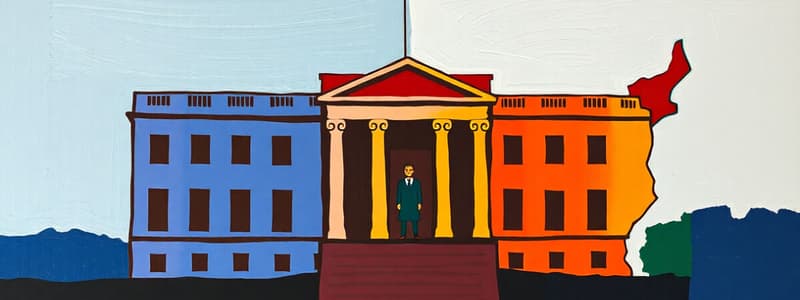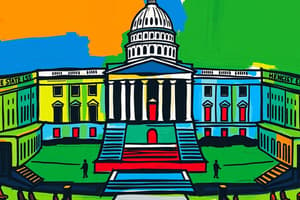Podcast
Questions and Answers
What is the primary purpose of a filibuster in the Senate?
What is the primary purpose of a filibuster in the Senate?
- To automatically pass legislation.
- To enforce a strict timeline for voting.
- To extend debate and delay a vote. (correct)
- To gather support for a bill.
Which statement correctly describes the concept of judicial activism?
Which statement correctly describes the concept of judicial activism?
- Ignoring the Constitution in favor of public opinion.
- Rigidly following the Constitution without interpretation.
- Interpreting the Constitution to address modern issues. (correct)
- Resisting changes to established legal precedents.
What is required to invoke cloture in order to end a filibuster?
What is required to invoke cloture in order to end a filibuster?
- 60 votes from the Senate. (correct)
- 50 votes from the Senate.
- A simple majority of 51 votes.
- A unanimous vote from all senators.
Which of the following exemplifies the free rider problem?
Which of the following exemplifies the free rider problem?
What principle is upheld in the case of McDonald v. Chicago?
What principle is upheld in the case of McDonald v. Chicago?
What is the primary function of a conference committee?
What is the primary function of a conference committee?
Which of the following accurately describes informal presidential powers?
Which of the following accurately describes informal presidential powers?
What role does the Rules Committee play in the House of Representatives?
What role does the Rules Committee play in the House of Representatives?
What is an example of an inherent power of Congress?
What is an example of an inherent power of Congress?
What does the doctrine of checks and balances primarily achieve?
What does the doctrine of checks and balances primarily achieve?
Which case established the principle of judicial review?
Which case established the principle of judicial review?
Which of the following best describes 'pork spending'?
Which of the following best describes 'pork spending'?
What is the purpose of unfunded mandates?
What is the purpose of unfunded mandates?
Flashcards
Logrolling
Logrolling
A practice where lawmakers agree to support each other's bills in exchange for votes on their own bills, leading to mutually beneficial legislation.
Filibuster
Filibuster
A tactic used in the Senate to delay a vote on a bill by continuously debating, potentially preventing a final decision.
Cloture
Cloture
A procedure that ends a filibuster and allows a vote on a bill, requiring a 60-vote supermajority in the Senate.
Judicial Activism
Judicial Activism
Signup and view all the flashcards
Free Rider
Free Rider
Signup and view all the flashcards
Standing Committee
Standing Committee
Signup and view all the flashcards
Checks and Balances
Checks and Balances
Signup and view all the flashcards
Formal Presidential Powers
Formal Presidential Powers
Signup and view all the flashcards
Enumerated Powers
Enumerated Powers
Signup and view all the flashcards
Congressional Oversight
Congressional Oversight
Signup and view all the flashcards
Federalist 78
Federalist 78
Signup and view all the flashcards
Baker v. Carr
Baker v. Carr
Signup and view all the flashcards
Rules Committee
Rules Committee
Signup and view all the flashcards
Study Notes
Congressional Committees
- Standing Committees: Permanent committees focusing on specific policy areas (e.g., finance, defense).
- Joint Committees: Composed of members from both the House and Senate, addressing issues like taxation.
- Conference Committees: Temporary committees reconciling differences between House and Senate versions of a bill.
Executive Office
- Executive Office of the President: A group of advisors assisting the President in policy implementation and federal management.
Government Structure
- Checks and Balances: A system where each branch of government can limit the powers of others.
- Executive and Legislative Branches: The Executive enforces laws, while the Legislative makes them.
Presidential Powers
- Formal Powers: Powers clearly stated in the Constitution (e.g., veto power).
- Informal Powers: Powers based on influence and persuasion (e.g., agenda-setting).
Congressional Powers
- House Powers: Initiates revenue bills and impeachment proceedings.
- Senate Powers: Confirms appointments, treaties, and holds impeachment trials.
- Enumerated Powers: Explicitly listed powers (e.g., taxation).
- Implied Powers: Powers not explicitly stated but necessary to carry out enumerated powers (Elastic Clause).
- Inherent Powers: Powers stemming from the sovereignty of Congress (e.g., border control).
Oversight and Influence
- Congressional Oversight: Congress's authority to monitor executive branch actions.
- Bully Pulpit: The President's ability to use their position to influence public opinion.
Landmark Documents and Cases
- Federalist 78: Advocates for an independent judiciary and judicial review.
- Federalist 70: Supports a strong, singular executive for accountability.
- Baker v. Carr: Courts can resolve redistricting issues, promoting "one person, one vote."
- Marbury v. Madison: Established judicial review, enabling courts to declare laws unconstitutional.
Legislative Processes
- Rules Committee: Determines debate and voting procedures for bills in the House.
- Ways and Means Committee: Manages tax policy and entitlement programs.
- Iron Triangle/Issue Network: The interaction among government agencies, committees, and interest groups affecting policy.
Education and Mandates
- No Child Left Behind: A law aiming to improve education through standards and accountability.
- Unfunded Mandates: Federal requirements imposed on states without funding.
Legislative Techniques
- Pork Spending: Local government spending viewed as wasteful but beneficial to constituents.
- Logrolling: Lawmakers trading votes to pass mutually beneficial legislation.
- Filibuster: A tactic to delay a Senate vote on a bill through extended debate.
- Cloture: A procedure to end a filibuster requiring 60 votes.
Economic Structures
- The FED: Manages the U.S. money supply and monetary policy.
- Federal Corporations: Government-run entities like the U.S. Postal Service.
Judicial Philosophy
- Judicial Activism: Interpreting the Constitution to address modern issues.
- Judicial Restraint: Adhering closely to the Constitution's original intent in rulings.
Additional Cases
- McDonald v. Chicago: Applied the Second Amendment to states via the 14th Amendment.
- Worcester v. Georgia: Recognized Native American tribes as sovereign, though often disregarded.
Senate Powers
- Advice and Consent Power: The Senate's authority to approve presidential appointments and treaties.
Public Goods Issue
- Free Rider: Individuals benefiting from services without contributing towards their cost.
Independent Agencies
- Independent Agencies: Federal organizations (e.g., NASA, EPA) operating outside executive departments, focusing on specific policy areas.
Studying That Suits You
Use AI to generate personalized quizzes and flashcards to suit your learning preferences.




